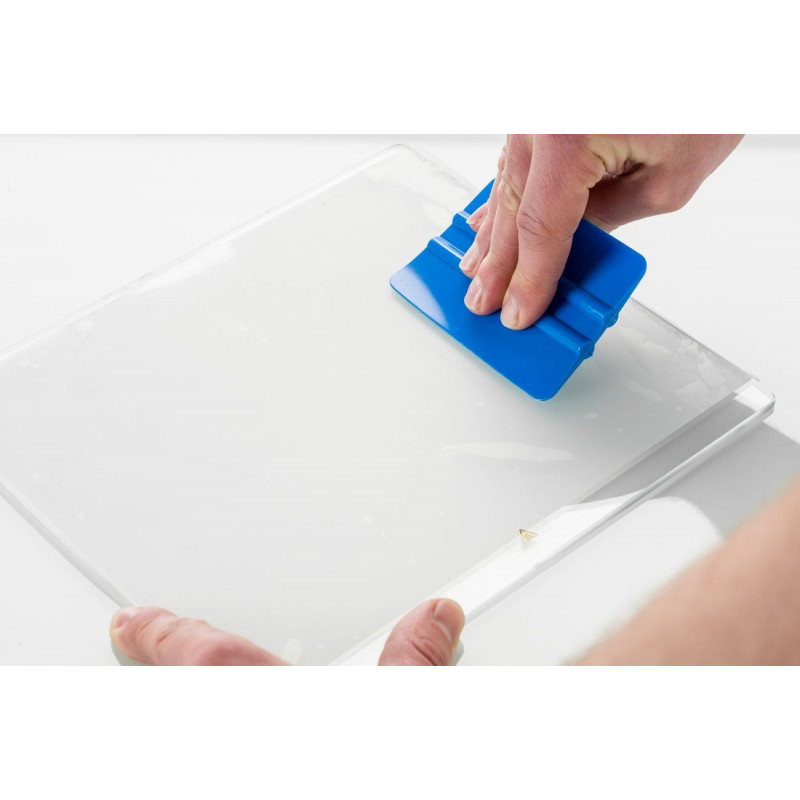

Different materials require different temperatures to ensure good adhesion. They are not squeezed on your build plate. In #3 there was too much space in between the nozzle and build plate because of the roundish layers you see at the top. You can see near the edges how the excessive material is being pushed to the outside. In example #2 you can see some transparency in the first layer, this is usually an indication that the build plate was too tight to the nozzle. The layers are spread out and squeezed on the build plate evenly. If the distance between your nozzle and build plate are correct and your first layer is printed at the right speed and thickness your first print should look like #1. You want the first layer to squeezed on the glass plate. Even when printing a high detailed 3D print, we recommend to print a thicker first layer, for the same reason as mentioned above. A slower first layer gives the filament time to be squeezed onto the bed through the pressure it receives from the nozzle.

We recommend printing your first layer at 20mm/s. This concerns among others the speed and thickness. In Cura, they're called ' initial layer' if you want to find them. Ultimaker Cura has default settings for the first layer. The calibration card has a thickness of 0.15mm, which is exactly how much space you want between your nozzle and bed. The less it has to compensate for, the better. For an Ultimaker 2, 2+ and Ultimaker Original you can use a calibration card supplied with the Ultimaker. It is advised to manually level your bed before active leveling, so a potential offset is reduced to a minimum already. Make sure your bed is level, and the space between your nozzle is not too much and not too tight.Īn Ultimaker 3 has active leveling which can help you achieve proper leveling. So, how can you ensure good bed adhesion? At the same time, when it does not adhere properly you are guaranteed of a fail. When your print properly adhered to your bed you can sit back and relax while your print finishes.

Remove any glue residue from the glass plate with a sponge and soap.Good bed adhesion is one of the most important facets of 3D printing. Continue switching to a different corner of the adhesion sheet in order to pull it off completely.ĥ. The sheet shouldn’t leave a sticky residue.Ĥ. Hold the glass plate under a tap and let the water run under the adhesion sheet while slowly pulling the sheet off at a 90-degree angle. Take one of the corners of the adhesion sheet and peel it approximately 3 cm from the glass plate surface.ģ. Remove the glass plate from the Ultimaker S5.Ģ. To remove the adhesion sheet from the glass plate, take the following steps:ġ. The adhesion sheet can be used multiple times, but once it has been damaged, you may need to replace it. Heat the build plate to 100 ✬ so the remaining water under the sheet can evaporate. Once the sheet is applied, and is bubble-free and dry, place the glass plate back in the printer and secure with the build plate clamps. If the bubbles can’t be removed, consider popping them with a needle.Ħ. Note: Air bubbles under the sheet can distort the first printed layer. To reduce the number of air bubbles, use the adhesive applicator to sweep the water outwards from underneath the sheet, starting at the center. Start in the middle and then lower the adhesion sheet onto the rest of the glass plate.ĥ. Remove the back liner from the adhesion sheet.Ĥ. Make sure that the glass plate’s warning sticker is facing upwards.ģ. For the best results, wet the glass plate with water and (optionally) a small amount of (dishwashing) soap. Remove the glass plate from the printer by opening the build plate clamps at the front of the build plate, then gently sliding the glass plate out of the printer.Ģ. To apply the adhesion sheet to the glass plate, take the following steps:ġ.
#Ultimaker cura adhesion how to
Learn how to apply it correctly, prevent air bubbles, and ensure a smoother, flatter surface. Using an adhesion sheet is one of the most effective methods of ensuring your 3D print adheres to the build plate, producing consistent high-quality results.


 0 kommentar(er)
0 kommentar(er)
